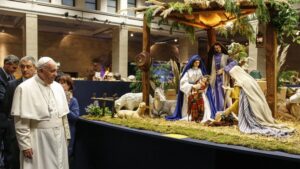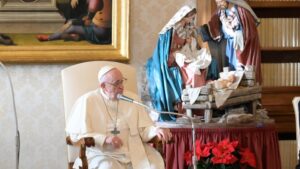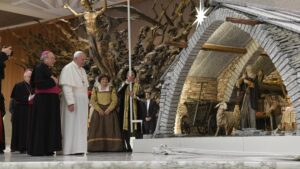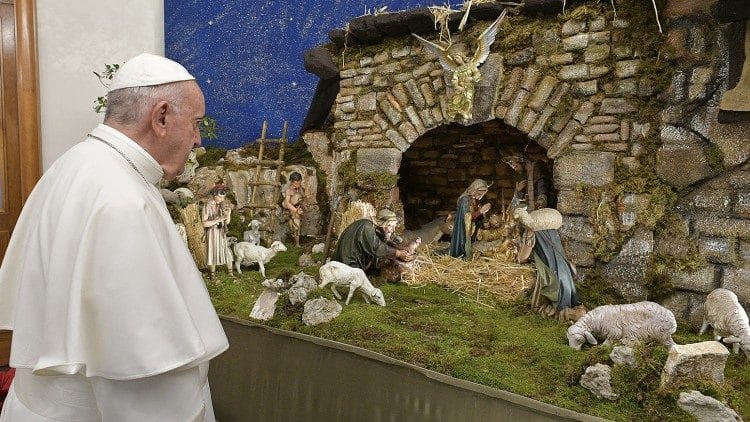The beautiful sign of the manger of the Holy Father Francis on the meaning and value of the Nativity scene:
1. The beautiful sign of the manger, so esteemed by the Christian people, always causes amazement and admiration. The representation of the event of the birth of Jesus is equivalent to announcing the mystery of the incarnation of the Son of God with simplicity and joy. The nativity scene, in fact, is like a living Gospel, which emerges from the pages of Holy Scripture. Contemplation of the Christmas scene invites us to set out spiritually, attracted by the humility of Him who became man to meet every man. And we discover that He loves us to the point of joining us, so that we too can join Him.
With this Letter I would like to encourage the beautiful tradition of our families who prepare the nativity scene in the days before Christmas, as well as the custom of placing it in the workplace, in schools, in hospitals, in prisons, in squares. …It is truly an exercise in creative fantasy, which uses the most disparate materials to create small masterpieces full of beauty. It is learned from childhood: when dad and mom, together with grandparents, transmit this joyful tradition, which contains within itself a rich popular spirituality. I hope this practice never weakens; In fact, I trust that, where it would have fallen into disuse, it will be discovered again and revitalized.

The Son of God, coming into this world, finds a place where the animals go to eat. The hay becomes the first bed for Him who will be revealed as “the bread that came down from heaven” (Jn 6:41). A symbolism that Saint Augustine, along with other Fathers, had already captured when he wrote: “Placed in the manger, he became food for us” (Serm. 189,4). In reality, the nativity scene contains various mysteries of the life of Jesus and makes them feel close to our daily lives.
But let us return again to the origin of the nativity scene as we understand it. We move with our minds to Greccio, in the Reatino valley; Saint Francis stopped there, probably coming from Rome, where on November 29, 1223 he had received confirmation of his Rule from Pope Honorius III. After his trip to the Holy Land, those grottoes reminded him in a special way of the landscape of Bethlehem. And it is possible that the Poverello was impressed in Rome by the mosaics of the Basilica of Santa Maria Maggiore that represent the birth of Jesus, right next to the place where, according to an ancient tradition, the tables of the manger were preserved.
The Franciscan Sources narrate in detail what happened in Greccio. Fifteen days before Christmas, Francisco called a local man, named Juan, and asked him to help him fulfill a wish: “I wish to celebrate the memory of the Child who was born in Bethlehem and I want to contemplate in some way with my eyes what he suffered in his disability as a child, how he was reclined in the manger and how he was placed on hay between the ox and the donkey»[1]. As soon as he heard it, that good and faithful man quickly went and prepared in the appointed place what the saint had indicated to him. On December 25, many friars from different places arrived in Greccio, as well as men and women from the farms in the region, bringing flowers and torches to illuminate that holy night. When Francis arrived, he found the manger with the hay, the ox and the donkey. The people who arrived showed indescribable joy in front of the Christmas scene, like they had never experienced before. Then the priest, before the Nativity, solemnly celebrated the Eucharist, showing the link between the incarnation of the Son of God and the Eucharist. On that occasion, in Greccio, there were no figures: the nativity scene was made and experienced by everyone present[2].
This is how our tradition is born: everyone around the grotto and full of joy, without any distance between the event that takes place and those who participate in the mystery.
The first biographer of Saint Francis, Thomas of Celano, remembers that that night, the gift of a wonderful vision was added to the simple and moving scene: one of those present saw the Baby Jesus himself lying in the manger. From that Christmas crib in 1223, “everyone returned to their homes filled with joy”[3].
3. Saint Francis carried out a great work of evangelization with the simplicity of that sign. His teaching has penetrated the hearts of Christians and remains to this day as a genuine way of simply representing the beauty of our faith. On the other hand, the same place where the first nativity scene was held expresses and evokes these feelings. Greccio has become a refuge for the soul that hides in the rock to let itself be enveloped in silence.
Why does the nativity scene arouse so much amazement and move us? First of all, because it manifests the tenderness of God. He, the Creator of the universe, lowers himself to our littleness. The gift of life, always mysterious to us, captivates us even more as we see that He who was born of Mary is the source and protection of every life. In Jesus, the Father has given us a brother who comes to look for us when we are disoriented and lose our way; a faithful friend who is always close to us; He has given us his Son who forgives us and lifts us from sin.
Preparing the manger in our homes helps us relive the story that happened in Bethlehem. Naturally, the gospels are always the source that allows us to know and meditate on that event; However, its representation in the nativity scene helps us imagine the scenes, stimulates emotions, invites us to feel involved in the history of salvation, contemporaries of the event that becomes alive and current in the most diverse historical and cultural contexts.
In a particular way, the manger is, from its Franciscan origin, an invitation to “feel”, to “touch” the poverty that the Son of God chose for himself in his incarnation. And so, it is implicitly a call to follow him on the path of humility, poverty, dispossession, which from the grotto of Bethlehem leads to the Cross. It is a call to find him and serve him with mercy in the brothers and sisters most in need (cf. Mt 25:31-46).
4. I would now like to review the various signs of the nativity scene to understand the meaning they carry. First of all, we represent the context of the starry sky in the darkness and silence of the night. We do it this way, not only out of fidelity to the Gospel stories, but also because of the meaning it has. Let’s think about how many times the night envelops our lives. Well, even in those moments, God does not leave us alone, but is present to answer the decisive questions about the meaning of our existence: Who am I? Where do I come from? Why was I born at this time? “Why I love?”? Why do I suffer? Why will I die? To answer these questions, God became man. His closeness brings light where there is darkness and illuminates those who go through the darkness of suffering (cf. Lk 1:79).

5. How much emotion should accompany us as we place the mountains, the streams, the sheep and the shepherds in the nativity scene! In this way we remember, as the prophets had announced, that all creation participates in the festival of the coming of the Messiah. The angels and the star are the sign that we too are called to set out to reach the grotto and worship the Lord.
“Let us therefore go to Bethlehem and see what has happened and what the Lord has told us” (Luke 2:15), so say the shepherds after the announcement made by the angels. It is a very beautiful teaching that is shown in the simplicity of the description. Unlike so many people who try to do a thousand other things, pastors become the first witnesses of what is essential, that is, of the salvation that is offered to them. It is the most humble and the poorest who know how to welcome the event of the incarnation. To God who comes to meet us in the Child Jesus, the shepherds respond by setting out towards Him, for an encounter of love and pleasant amazement. This encounter between God and his children, thanks to Jesus, is what gives life precisely to our religion and constitutes its singular beauty, and shines in a particular way in the manger.
6. We have the habit of putting many symbolic figures in our nativity scenes, especially those of beggars and people who know no other abundance than that of the heart. They are also close to the Baby Jesus in their own right, without anyone being able to throw them out or take them away from a crib so improvised that the poor around them do not clash at all. In fact, the poor are the privileged of this mystery and often those who are most capable of recognizing the presence of God in our midst.
The poor and the simple at the Nativity remember that God becomes man for those who most feel the need for his love and ask for his closeness. Jesus, “meek and humble in heart” (Mt 11:29), was born poor, he lived a simple life to teach us to understand what is essential and to live from it. From the nativity scene the message clearly emerges that we cannot be fooled by wealth and by so many ephemeral proposals of happiness. Herod’s palace is in the background, closed, deaf to the announcement of joy. By being born in the manger, God himself initiates the only true revolution that gives hope and dignity to the disinherited, the marginalized: the revolution of love, the revolution of tenderness. From the nativity scene, Jesus proclaims, with gentle power, the call to share with the least the path to a more human and fraternal world, where no one is excluded or marginalized.
Children—but also adults!—often love to add other figures to the nativity scene that seem to have no relationship with the gospel stories. And yet, this imagination seeks to express that in this new world inaugurated by Jesus there is room for everything that is human and for every creature. From the shepherd to the blacksmith, from the baker to the musicians, from the women who carry jugs of water to the children who play…, all this represents everyday holiness, the joy of doing everyday things in an extraordinary way, when Jesus shares his divine life with us.
7. Little by little, the nativity scene takes us to the grotto, where we find the figures of Mary and Joseph. Mary is a mother who looks at her son and shows him to all who come to visit him. The image of her makes us think of the great mystery that has enveloped this young woman when God has knocked on the door of her immaculate heart. Before the announcement of the angel, who asked her to be the mother of God, Mary responded with full and total obedience. Her words: «Behold the handmaid of the Lord; let it be done to me according to your word” (Luke 1:38), are for all of us the testimony of abandonment in faith to the will of God. With that “yes”, Mary became the mother of the Son of God without losing her virginity, but rather consecrating it thanks to Him. We see in her the Mother of God who does not have her Son only for herself, but who asks to all to obey his word and put it into practice (cf. Jn 2:5).

8. The heart of the manger begins to beat when, at Christmas, we place the image of the Baby Jesus. God presents himself like this, in a child, to be received in our arms. In weakness and fragility he hides the power of him that creates and transforms everything. It seems impossible, but it is like this: in Jesus, God was a child and in this condition he wanted to reveal the greatness of his love, which is manifested in his smile and in reaching out his hands to everyone.
The birth of a child arouses joy and wonder, because it puts us before the great mystery of life. Seeing the eyes of the young couple shine before their newborn son, we understand the feelings of Mary and Joseph who, looking at the baby Jesus, perceived the presence of God in their lives.
«Life became visible» (1Jn 1,2); Thus the apostle John summarizes the mystery of the incarnation. The nativity scene makes us see, makes us touch, this unique and extraordinary event that has changed the course of history, and from which the numbering of the years is also ordered, before and after the birth of Christ.
God’s way of acting almost stuns, because it seems impossible for Him to renounce his glory to become a man like us. What a surprise to see God assuming our own behaviors: he sleeps, drinks his mother’s milk, cries and plays like all children. As always, God baffles, he is unpredictable, he continually goes beyond our schemes. Thus, the manger, while showing us God as he came into the world, invites us to think about our life grafted into God’s; He invites us to be his disciples if we want to reach the ultimate meaning of life.
9. When the feast of the Epiphany approaches, the three figures of the Three Wise Men are placed in the Nativity scene. Observing the star, those wise and rich lords from the East had set out for Bethlehem to meet Jesus and offer him gifts: gold, frankincense and myrrh. These gifts also have an allegorical meaning: the gold honors the royalty of Jesus; the incense the divinity of him; the myrrh the holy humanity of him who will know death and burial.
Contemplating this scene in the nativity scene, we are called to reflect on the responsibility that each Christian has to be an evangelizer. Each one of us becomes a bearer of the Good News with those he meets, witnessing with concrete actions of mercy the joy of having found Jesus and his love.
The Magi teach that you can start from very far away to reach Christ. They are rich men, wise foreigners, thirsty for the infinite, who set out on a long and dangerous journey that takes them to Bethlehem (cf. Mt 2:1-12). A great joy invades them before the Child King. They do not allow themselves to be scandalized by the poverty of the environment; They do not hesitate to get on their knees and worship him. Before Him they understand that God, just as He regulates the course of the stars with sovereign wisdom, guides the course of history, lowering the powerful and exalting the humble. And certainly, upon arriving in their country, they will have told of this surprising encounter with the Messiah, inaugurating the journey of the Gospel among the people.
10. In front of the nativity scene, the mind spontaneously goes to when one was a child and was impatiently waiting for the time to start building it. These memories lead us to become aware again of the great gift that has been given to us by transmitting the faith; and at the same time they make us feel the duty and joy of transmitting the same experience to our children and grandchildren. It is not important how the manger is prepared, it can always be the same or be modified each year; What counts is that it speaks to our lives. In any place and in any way, the nativity scene speaks of the love of God, the God who has become a child to tell us how close he is to every human being, whatever their condition.
Dear brothers and sisters: The nativity scene is part of the sweet and demanding process of transmitting the faith. Starting from childhood and then at each stage of life, it educates us to contemplate Jesus, to feel God’s love for us, to feel and believe that God is with us and that we are with Him, all children and brothers, thank you to that Child, Son of God and the Virgin Mary. And to feel that this is where happiness lies. May we in the school of Saint Francis open our hearts to this simple grace, let a humble prayer be born from amazement: our “thank you” to God, who wanted to share everything with us so as to never leave us alone.
FRANCIS
Given in Greccio, in the Sanctuary of the Manger, December 1, 2019.
[1] Thomas of Celano, First Life, 84: Franciscan Sources (FF), n. 468.
[2] Cf. ibid., 85: FF, n. 469.
[3] Ibid., 86: FF, n. 470.










